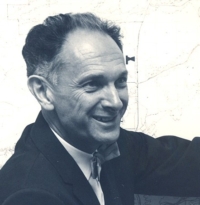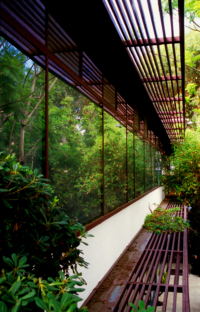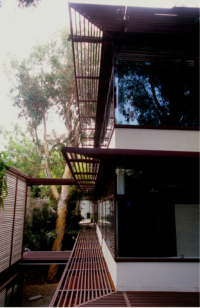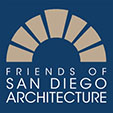By Todd Pitman, ASLA
 Lloyd Ruocco was arguably San Diego’s most influential modernist architect. He and his wife, Ilse Hamann Ruocco, inspired a generation of creative thinkers, architects, artists, and craftspeople. His legacy is carried forward by the art and architecture community of our city. Ruocco challenged architects and planners to “design cities fit for living”. Following World War II, he saw the immense opportunities to harness the newest technologies and materials for use in architecture, art, and urban design. New efficiencies could afford opportunities for all to own their own homes. Further, this optimism could lead to a rebirth of our city. San Diego would become a world class civic center providing art, culture, and vitality to all. His influence was furthered by his architectural practice which, along with his wife’s interior design offices, was located in the Design Center at the intersection of Fifth Avenue and Brookes Avenue in Hillcrest. The Design Center would become ground zero for San Diego’s distinct form of regional modernism, serving as a training ground for many who would later become creative leaders in their own right.
Lloyd Ruocco was arguably San Diego’s most influential modernist architect. He and his wife, Ilse Hamann Ruocco, inspired a generation of creative thinkers, architects, artists, and craftspeople. His legacy is carried forward by the art and architecture community of our city. Ruocco challenged architects and planners to “design cities fit for living”. Following World War II, he saw the immense opportunities to harness the newest technologies and materials for use in architecture, art, and urban design. New efficiencies could afford opportunities for all to own their own homes. Further, this optimism could lead to a rebirth of our city. San Diego would become a world class civic center providing art, culture, and vitality to all. His influence was furthered by his architectural practice which, along with his wife’s interior design offices, was located in the Design Center at the intersection of Fifth Avenue and Brookes Avenue in Hillcrest. The Design Center would become ground zero for San Diego’s distinct form of regional modernism, serving as a training ground for many who would later become creative leaders in their own right.
Born in Maine and arriving in San Diego as a young boy in the early 1920s, Ruocco immersed himself within the architectural community that thrived in San Diego in the early part of the last century. His first position was as a draftsman in the offices of Richard Requa, while still in high school. Here Ruocco was exposed to the
Mediterranean styles that had become immensely popular throughout Southern California. At work in Requa’s office and prior to his graduation from San Diego High School, Ruocco developed a sensitive respect for siting, and specifically the relationship of the built environment to the outdoors.
Following his graduation from the University of California, Berkeley, he returned to San Diego and worked in the offices of Requa Jackson as well as William Templeton Johnson. He would assist on the 1935 Panama Exposition, City and County Administration Building, as well as the master plan for the community of Rancho Santa Fe under the supervision of his college drafting instructor, Lillian Rice. Furthering their ideals and understanding of architecture and urban design, the Ruocco’s would travel extensively to the world’s great cities.
Growing increasingly dissatisfied with the rehashed revival styles that prevailed through the 1930s, Ruocco opened his own offices in hopes of bringing a more modern style of architecture to San Diego. He would go on to design well over 150 projects throughout San Diego County. Ruocco is responsible for several projects that are considered by many to be some of the area’s best examples of the period. Of particular note is the aforementioned Design Center (c.1949) and the Institute of Geophysics and Planetary Physics at UC San Diego’s Scripps Institution of Oceanography (c.1963). However, Ruocco is perhaps best known for his simple wood and glass homes that began to dot hillsides and canyons from the 1930s through the early 1970s. His projects can be found throughout San Diego County with the greatest concentrations in Mission Hills, Mount Helix, Point Loma, and La Jolla.
Ruocco was equally devoted to the art community as well as to the city itself. He was instrumental in founding several community design organizations: Citizens Coordinate for Century 3, Allied Artists, and Allied Craftsmen. He was also instrumental in the publication of several textbooks, written to bring art and design to school curriculums throughout the country. His ultimate goal was to better the lives of the people of San Diego through his tireless efforts to promote and encourage education, art, architecture, and design. Many would say that he certainly achieved his goal.
In part through gift funding that was set up prior to his passing, Ruocco Park was opened at the central section of the Embarcadero in 2013. It serves as an interactive public space that integrates the use of landscape and art for the benefit of the public to gather, view, and enjoy the waterfront and skyline of San Diego.
Lloyd Ruocco’s influence on San Diego is evident even today.
Photo of Lloyd Ruocco–courtesy of Todd Pitman Ruocco Archive
Photos below of Ruocco Office: Courtesy of Michael-Leonard Creditor


